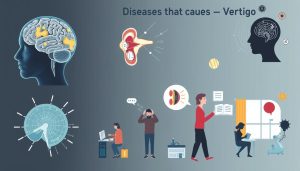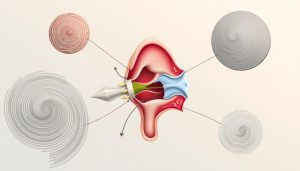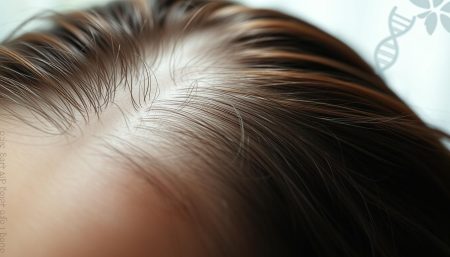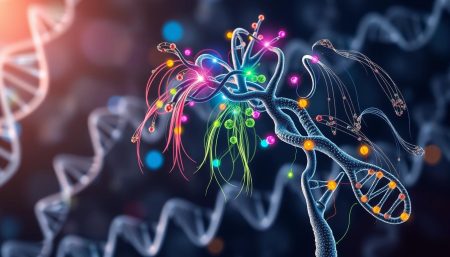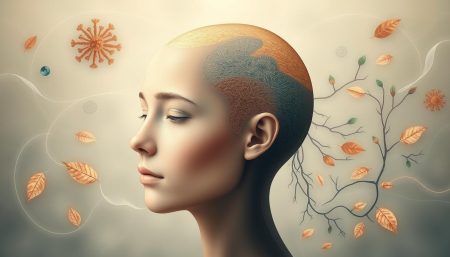Many people are confused about hair loss. Understanding alopecia is key to health. Hair shows who we are and how we feel. Knowing the causes of alopecia helps those affected feel more in control.
Hair loss has many reasons, from biology to environment. This article aims to clear up the mystery of alopecia. You’re not alone in this journey. Hair loss reasons are complex, tied to our health and lifestyle.
Exploring alopecia combines empathy and science. You’re about to learn about alopecia’s many sides. This will give you facts and support through hair loss challenges.
Key Takeaways
- Recognizing the diversity and complexity of alopecia causes.
- Gaining a compassionate understanding of the emotional impact of hair loss.
- Prefacing the discussion with a human touch, making medical information more accessible.
- Preparing to explore a holistic view of hair loss triggers and responses.
- Building a knowledge foundation for further insight into environmental and genetic factors.
Introduction to Alopecia and Hair Loss
Exploring understanding hair loss is key. It’s important to know the difference between normal hair shedding and alopecia. Losing a lot of hair can signal a health problem. This part aims to give an alopecia overview, explaining how it differs from regular hair loss and its effects on people.
Alopecia means hair loss but includes many types of hair loss. It can be mild thinning or complete baldness. It can be caused by genetics, medical issues, or lifestyle. Knowing the types and causes helps in treating and coping emotionally.
- Alopecia Areata: Appears as patchy hair loss and can suddenly occur on various parts of the body.
- Androgenetic Alopecia: Often referred to as male or female pattern baldness, this type affects many adults.
- Cicatricial Alopecia: This condition results in scar tissue replacing hair follicles, leading to permanent loss.
- Traction Alopecia: Caused by excessive styling or pulling on the hair.
Understanding hair loss and its types is crucial. It helps address the emotional impact on those affected. Hair loss can affect self-esteem and body image, making social interactions harder.
As we delve deeper into alopecia, remember it has many forms. It needs a caring approach to treatment and coping. The journey to understanding starts with knowing its different types and embracing support for healing and acceptance.
The Different Types of Alopecia
Alopecia is a common condition that causes hair loss in different ways. Each type has its own hair loss pattern. Knowing about these types can help people find the right treatment.
Androgenetic Alopecia: Pattern Baldness
Androgenetic alopecia is the most common hair loss condition. It’s also known as pattern baldness. Men lose hair in a specific pattern, while women experience thinning on the crown. Hormones play a big role in this type of hair loss.
Alopecia Areata: Sudden Patchy Hair Loss
Alopecia areata causes hair loss in sudden, patchy spots. It’s an autoimmune condition that attacks hair follicles. This can lead to fast and sometimes reversible hair loss.
Cicatricial Alopecia: Scarring Hair Loss
Cicatricial alopecia is a permanent hair loss condition. It happens when inflammatory cells destroy hair follicles, leaving scars. Early diagnosis and treatment are key because it’s irreversible.
Traction Alopecia: Hairstyling-Induced Loss
Traction alopecia is caused by tight hairstyles that pull on the hair. This can lead to hair loss, especially around the forehead and temples. It’s a preventable type of hair loss.
| Type of Alopecia | Typical Onset | Common Signs | Reversibility |
|---|---|---|---|
| Androgenetic Alopecia | Gradual | Receding hairline, hair thinning on crown | Possibly with treatment |
| Alopecia Areata | Sudden | Patchy hair loss | Often reversible |
| Cicatricial Alopecia | Progressive | Scarring, permanent hair loss | No |
| Traction Alopecia | Gradual | Hairline recession, thinning around temples | Yes, if early intervention |
Genetic Factors in Hair Loss
Understanding genetics in hair loss is key for those worried about their hair. Hereditary hair loss comes from baldness genes passed down from parents. This often leads to androgenetic alopecia, affecting both men and women. Knowing your family history can show if you’re likely to lose hair due to genes.
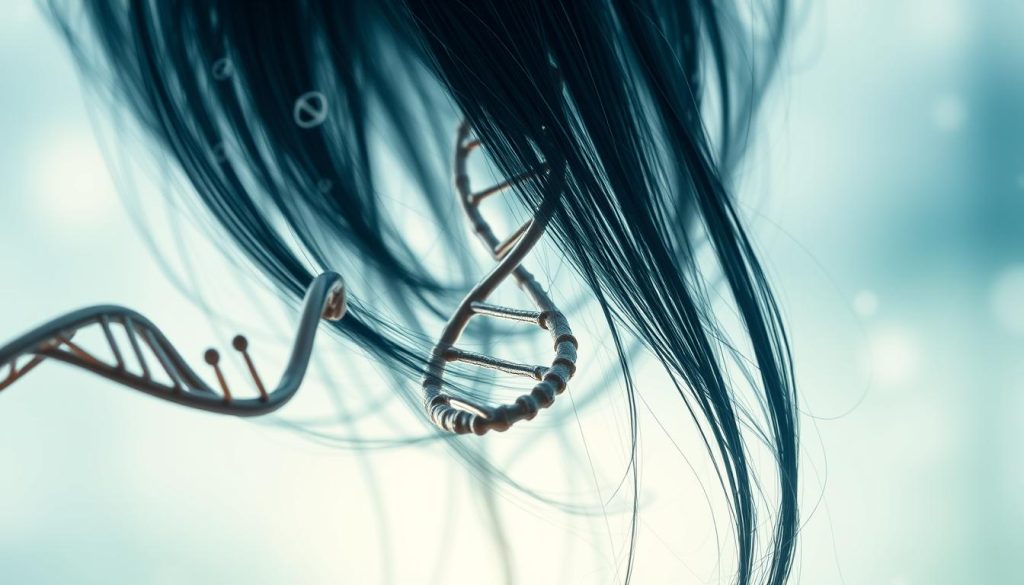
Genetics do more than just decide if you’ll lose hair. They also affect when, how, and how much hair you’ll lose. Knowing these genetic factors helps in making treatment plans and setting realistic goals.
Genetic predisposition to alopecia is not just about losing hair but understanding how your body reacts to different hormonal changes influenced by genes.
- Identifying baldness genes in family history
- Evaluating risk factors for hereditary hair loss
- Exploring preventive measures and treatments
| Factor | Impact on Hair Loss | Possible Interventions |
|---|---|---|
| Family History | High likelihood of inheriting similar patterns | Genetic counseling |
| Age of Onset | Early onset might suggest stronger genetic influence | Early therapeutic approaches |
| Severity | Varies with the gene variant | Customized treatment plans |
In conclusion, hair loss genetics are complex, involving many genes and environmental factors. By understanding hereditary hair loss, people can better manage their condition. This knowledge helps in finding the right treatments to control symptoms.
Environmental Impacts on Hair Health
Looking into how the environment affects hair health shows us a lot. It tells us how things outside of us can lead to hair loss. With pollution getting worse, knowing about hair health environmental factors is key. It helps us prevent and treat alopecia.
Studies show that things like air pollution, dirty water, and chemicals can harm hair. They can cause hair loss, slow down hair growth, and change its texture.
In cities, where air is full of pollutants like smoke and chemicals, more people lose their hair. These pollutants can settle on the scalp and hair. They can harm the follicles and cause different types of alopecia.
| Environmental Factor | Impact on Hair Health | Example |
|---|---|---|
| Air Pollutants | Reduces hair protein levels leading to weakening and breakage | Industries, vehicles emissions |
| Water Contaminants | Alters hair texture and can trigger scalp diseases | Heavy metals, chlorine in water supply |
| UV Radiation | Causes hair protein degradation and color loss | Excessive exposure to sun |
If you’re losing hair, knowing what causes it is important. Simple steps like washing your hair after being outside, using water filters, and using hair products that protect against pollution can help.
Talking more about protecting the environment and hair health is also important. It could help reduce these negative effects. This could lead to better living conditions and healthier hair.
What Causes Alopecia: In-Depth Look at Triggers
Understanding alopecia triggers is complex. It involves genetics, environment, and health. This section looks at the main alopecia causes. It explains why and how these factors can cause hair loss.
Scalp infections or illnesses can start alopecia. But, harsh hair care and certain medicines also matter. These can harm hair follicles, causing thinning and baldness.
| Cause | Effect on Hair | Potential for Reversibility |
|---|---|---|
| Scalp Infections | Damage to hair follicles, impeding natural growth | Often reversible with treatment |
| Harsh Hair Treatments | Breakage and weakening of hair shafts | Possibly reversible if caught early |
| Systemic Medications | Disruption of hair cycle leading to shedding | Reversible upon cessation of medication |
Each hair loss trigger affects people differently. It depends on health and genes. If you’re losing hair, talk to a doctor. They can help figure out your alopecia causes.
Autoimmune Responses and Hair Loss
In this section, we explore autoimmune hair loss. We focus on alopecia areata, an autoimmune disorder. It leads to hair loss through an alopecia areata immune response. Knowing about this condition is key for those with unexplained hair loss.
Understanding Autoimmune Hair Loss
Autoimmune hair loss happens when the autoimmune system sees hair follicles as enemies. It attacks them, causing hair to fall out. This can be very upsetting, as people see clumps of hair and bald spots.
The autoimmune response affects people differently. Some have small spots, while others have bigger areas of hair loss.
Link Between Alopecia Areata and Immune System
The immune system and hair health are closely linked in alopecia areata. The immune system’s cells harm the hair follicles. This leads to less hair growth and bald patches.
This condition can switch between hair loss and regrowth. It’s hard to manage without help from experts.
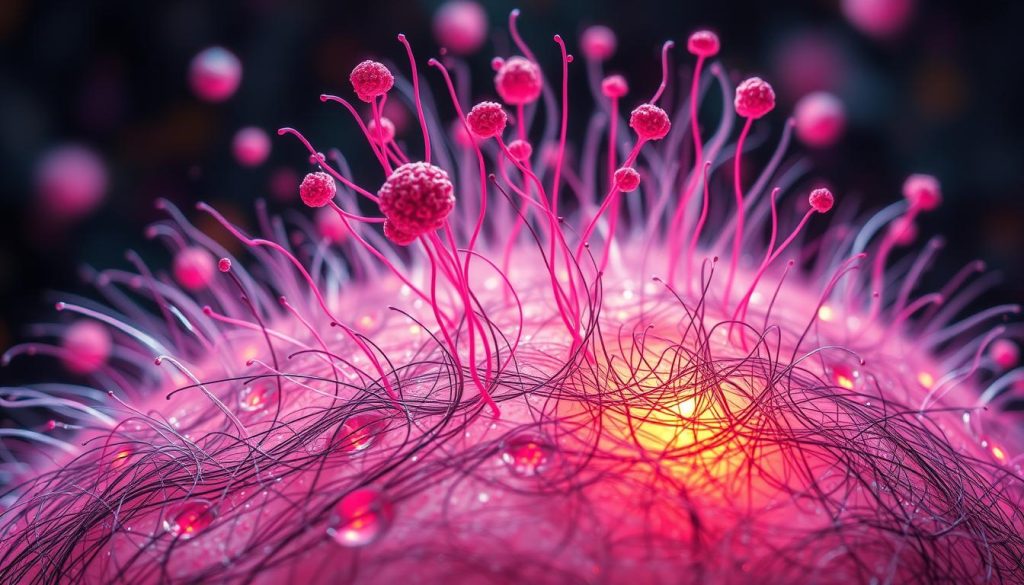
For those affected, knowing how the autoimmune system affects hair is crucial. Talking to doctors, looking into treatments, and joining support groups can help. New treatments offer hope for managing this condition.
Hormonal Imbalances and Hair Thinning
Hormonal hair loss and hair thinning hormones are key in hair health. Experts often look into these when they diagnose alopecia. The endocrine system alopecia deals with hormones that control growth, reproduction, and metabolism. These hormones affect the hair growth cycle.
Conditions like polycystic ovary syndrome (PCOS) and thyroid imbalances can cause hair changes. These changes include less dense and different hair texture. This shows how hormonal imbalances can harm hair health.
Other factors, like menopause and pregnancy, also lead to hormonal changes. These changes can cause hair to thin or fall out.
| Hormonal Condition | Common Symptoms | Impact on Hair Health |
|---|---|---|
| PCOS | Irregular menstrual cycles, weight gain | Increase in hair thinning hormones, leading to sparse hair |
| Thyroid Disorders | Fatigue, weight fluctuation | Hypothyroidism or hyperthyroidism can cause brittle hair or alopecia |
| Menopause | Hot flashes, mood swings | Decreased estrogen levels can result in hormonal hair loss |
| Pregnancy | Nausea, body aches | Hormonal surges and drops which might cause hair to thin postpartum |
The conditions listed show how important hormonal balance is. Hair follicles are very sensitive to hormonal changes. Fixing these imbalances through medicine, lifestyle changes, and good nutrition can help stop hormonal hair loss. It also supports hair growth.
Stress-Related Hair Loss Explained
Understanding how stress affects hair loss is crucial. Recent studies show that chronic stress can disrupt hair growth. This leads to conditions like stress-induced alopecia. By looking at how stress affects our bodies, we can find ways to manage it better.
How Stress Affects Hair Follicles
When we’re stressed, our body makes more stress hormones. These hormones, like cortisol, can harm hair follicles. They can make hair grow shorter, leading to thinning and shedding.
Research shows stress also reduces the activity of stem cells in hair follicles. This is because stress suppresses the GAS6 molecule, which helps hair grow.
Tips for Managing Stress-Induced Alopecia
To fight stress’s impact on hair, managing stress is key. Here are some tips:
- Eat a balanced diet full of vitamins and minerals good for hair.
- Do regular exercise to help lower stress.
- Try mindfulness like meditation or yoga to reduce stress.
- See a doctor for stress therapies and hair treatments.
Managing stress and hair loss needs both prevention and action. Knowing the causes of stress-induced alopecia helps us recover. It ensures our mental and physical health.
| Factor | Impact on Hair Loss | Suggested Management Strategy |
|---|---|---|
| Chronic Stress | Increases cortisol levels leading to hair follicle shrinkage and slower hair growth. | Engage in regular stress-relieving activities like yoga and meditation. |
| Diet | Poor nutrition can exacerbate hair loss. | Ensure intake of nutrients known to support hair health, such as Vitamin C, Biotin, and Zinc. |
Nutritional Deficiencies Leading to Bald Spots
Understanding how nutrition affects hair health is key to fighting diet-related hair loss. Not getting enough nutrients can lead to weak, thinning hair or bald spots. These problems often come from not getting enough important vitamins and minerals.
Alopecia nutrition is very important. What we eat every day can greatly affect our hair’s growth and strength. Eating foods rich in nutrients helps keep hair follicles healthy and prevents alopecia caused by lack of nutrients.
This section will explore which nutrients are crucial for healthy hair and how not getting them can lead to alopecia. We will also give tips on how to eat more foods that are good for your hair.
Ensuring a well-rounded diet rich in specific vitamins and minerals is foundational to combatting hair loss effectively.
- Vitamin D – Promotes hair follicle cycling
- Iron – Essential for hemoglobin production which aids in hair growth
- Zinc – Supports hair tissue growth and repair
- B-Vitamins – Enhance hair strength by aiding in red blood cell production
Vitamins like Vitamin C, Vitamin E, and Biotin are very important for fighting hair loss. Eating a balanced diet that includes these nutrients can help prevent hair thinning and loss.
| Nutrient | Role in Hair Health | Common Food Sources |
|---|---|---|
| Vitamin C | Collagen production and iron absorption | Citrus fruits, strawberries, peppers |
| Vitamin E | Protects hair cells from oxidative stress | Nuts, spinach, avocados |
| Biotin (Vitamin B7) | Improves hair’s keratin infrastructure | Eggs, nuts, whole grains |
| Folic Acid (Vitamin B9) | Helps in tissue growth and cell function | Green leafy vegetables, beans, seeds |
| Zinc | Aids in hair tissue growth and repair | Meat, shellfish, legumes |
Eating foods rich in these nutrients can greatly improve your hair health. If you’re experiencing hair thinning or loss, talking to a healthcare provider about changing your diet or taking supplements might be a good idea.
Conclusion
When facing alopecia, knowing what to do is key. We’ve looked into why hair loss happens, from genetics to environmental factors. Understanding these can help in managing hair loss, which is both personal and universal.
Preventing alopecia is crucial. We’ve highlighted the importance of medical knowledge and community support. This helps in the fight against hair loss.
Dealing with hair loss is more than just about looks. It’s about feeling good about oneself. We’ve shared tips on hormonal issues, stress, and nutrition. Overcoming alopecia takes time, patience, and sometimes, a doctor’s help.
Our goal is to help you find your way. Use what you’ve learned to keep learning. Remember, you’re not alone in this fight. Keep learning and sharing to build hope and resilience against alopecia.
FAQ
Q: What are common causes of alopecia?
A: Alopecia can come from many sources. This includes genetics, autoimmune diseases, and hormonal imbalances. Nutrient deficiencies, environmental factors, and stress also play a role.
Q: Are there different types of alopecia?
A: Yes, there are several types. Androgenetic alopecia, or pattern baldness, is one. Alopecia areata causes sudden patchy hair loss. Cicatricial alopecia leads to scarring hair loss. Traction alopecia is caused by hairstyling.
Q: How does genetics influence hair loss?
A: Genetics can greatly affect hair loss. In androgenetic alopecia, a family history of baldness increases the risk. This is because of inherited traits.
Q: Can external environmental factors contribute to hair loss?
A: Yes, they can. Pollutants and toxins can harm hair health. This can lead to hair loss.
Q: What triggers might initiate alopecia?
A: Several things can trigger alopecia. Infections, certain medications, and harsh hair care are examples. Underlying health conditions like autoimmune diseases also play a part.
Q: How does the immune system relate to alopecia areata?
A: In alopecia areata, the immune system attacks hair follicles. It sees them as foreign. This results in hair loss.
Q: What role do hormones play in hair thinning?
A: Hormonal imbalances can cause hair thinning. This includes thyroid disorders or PCOS. These imbalances can change hair density and texture.
Q: Can stress cause hair to fall out?
A: Yes, stress can affect hair follicles. This can lead to hair loss. Managing stress through lifestyle changes can help.
Q: How can nutritional deficiencies lead to hair loss?
A: Lack of certain vitamins and minerals can cause hair loss. This includes iron, zinc, and vitamins B and D. Eating a balanced diet can help prevent this.
Q: What can I do to manage and prevent hair loss?
A: To manage hair loss, take a multi-faceted approach. Seek professional advice and eat a healthy diet. Reduce stress and avoid harsh hair care. Treat any health conditions that may cause hair loss.




